Matador Network's Blog, page 1062
July 5, 2019
Bra clasps used to repair shells

An initiative from North Carolina-based nonprofit group Carolina Waterfowl Rescue is living proof that upcycling can be used to save lives.
The organization, which provides sanctuary, rescue, and rehabilitation services to a wide variety of wildlife, has recently been inundated with a high number of injured turtles, many of which have had their shells fractured after being hit by cars, boats, and even lawnmowers. A fix was in order to keep the shells of these poor reptiles together, and it was found in part of an everyday clothing item — the simple bra clasp.
The group found a way to use discarded bra clasps as an anchor to keep broken turtle shells together with wires to help them heal.
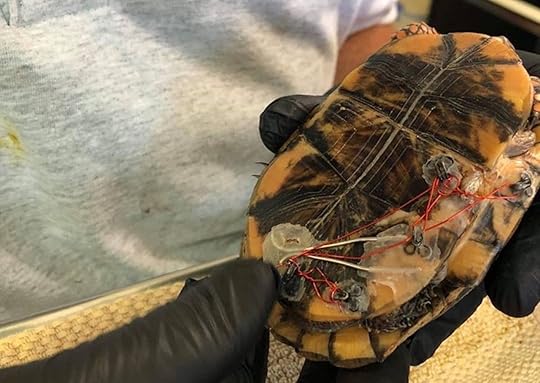
Photo: Carolina Waterfowl Rescue/Facebook
Turtle injuries are common this time of year, as many species move inland to lay eggs in the spring and often attempt to make their way across roadways and other busy areas. Smithsonian reported that the organization has been taking in as many as 40 injured turtles per week.
After putting out a Facebook post asking for bra clasp donations (and crediting Iowa’s Wildthunder Wildlife & Animal Rehabilitation and Sanctuary that first had the idea), the organization has received more than enough for this season. The group is now asking those wishing to send a bra clasp to instead donate the few dollars it would take to ship the clasps to them. “If everyone did this the turtles would never want for anything again,” the group wrote via its Facebook page. 

More like this: The best 8 places to see some of the world’s most majestic animals up close
The post Your old bra clasps can help save the lives of injured turtles appeared first on Matador Network.

Free Broadways shows in NYC
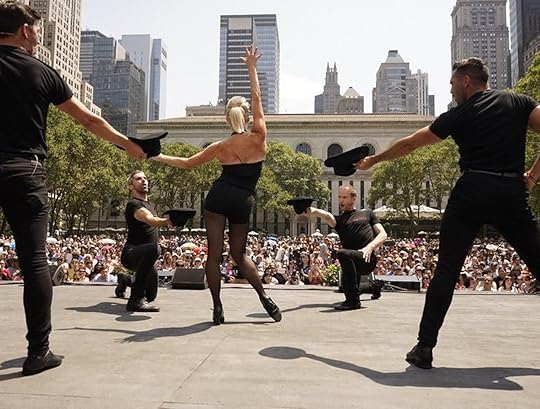
What insane amount of money New Yorkers pay in rent prices they recoup, at least partially, in free cultural happenings. Broadway in Bryant Park, the popular annual series which brings scaled-down versions of Broadway classics to the Manhattan park, will return for its 20th season this summer.
Each performance is a mini-musical starring actors from three separate shows performing hit songs and routines. Performances will include the biggest hits from classic musicals including The Phantom of the Opera, Jersey Boys, and Chicago. There’s also a “Disney on Broadway Takeover” on July 25, with songs from Aladdin, The Lion King, and Frozen to be performed.
The series kicks off on Thursday, July 11 through August 15. Performances take place each Thursday in Bryant Park’s amphitheater from 12:30 to 1:30 PM. Lawn space is open and free, though you may need to arrive early to snag a seat. The full show schedule can be viewed on Bryant Park’s website. If your lunch break ends before the performance concludes or starts before it begins, you can hack the system by showing up early to catch the rehearsals, which take place on the same stage in the park. 

More like this: 5 NYC parks you should visit that aren’t Central Park
The post See the most popular Broadway shows for free in New York City this summer appeared first on Matador Network.

July 4, 2019
Ice cream truck rejects influencers

The tide may be turning for social media influencers — at least as far as soft-serve ice cream is concerned. CVT Soft Serve, a Los Angeles-based ice cream shop that in 2014 threw a “Bill Murray Ice Cream Social” that actually got Bill Murray to show up, posted a jab at the darlings of social media in its window. The sign proclaimed that all food influencers would now be charged double price for their ice cream, a stunt that promptly found itself making the rounds on social and even landed on Reddit’s front page.
Nicchi had noticed an increase in asks from influencers in recent years. “At first I was confused,” Nicchi told the Los Angeles Times. “It’s like, ‘Hey, what’s up. So, I don’t know if you follow me but I have 100,000 followers. Could you hook me up with an ice cream? I’ll post about you in my story.’”
“It’s literally a $4 item,” Nicchi wrote on the shop’s Instagram channel. “We’ve decided to make this thing official with signage. We truly don’t care if you’re an Influencer, or how many followers you have,” the post said. “We will never give you a free ice cream in exchange for a post on your social media page. It’s literally a $4 item… well now it’s $8 for you.”
CVT Soft Serve serves ice cream out of a vintage 1960s Mister Softee truck, which it has operated since 2014. Only three flavors are served — chocolate, vanilla, and a twist of the two. In a nice bout of irony, pro wrestler John Cena posted a photo of Nicchi holding the sign, prompting it to go viral in a nod to his own influencer status. 
H/T: Los Angeles Times

More like this: Thanks, ‘influencers!’ Visiting natural landmarks is now pure hell
The post LA ice cream truck posts ‘influencers pay double’ sign, goes full viral appeared first on Matador Network.

Europe sets record for hottest June

If your brow seemed damper than normal in June, you certainly weren’t alone. Many heavily populated locations, including parts of the United States and Europe, were hit by an extreme heat wave that saw temperatures reach record levels in multiple places. According to a report by CNN, this past month was the hottest June ever recorded in Europe, with average temperatures hitting 1°C over the prior record for the month, set in June of 1999.
The cause of the heatwave was hot air blowing in from the Sahara Desert, which covered much of the European Union in the record heat for about one week. While not as extensive as the 2018 heatwave that hit the continent from April to December last year, for Europeans and those visiting the continent on summer trips, it was a hot month no matter how you look at it.
Copernicus Climate Change Service, which studies weather patterns and monitors the impact of climate change across the EU, also said that “the global-average temperature for June 2019 was also the highest on record for the month.”
Because of the “greenhouse effect” of methane and carbon dioxide, exacerbated by excessive use of fossil fuels across the planet, heat is trapped in the Earth’s atmosphere, causing increasingly hotter temperatures. “Although it is difficult to directly attribute this heatwave to climate change, such extreme weather events are expected to become more common as the planet continues to warm under increasing greenhouse gas concentrations,” the Copernicus Climate Change Service said. 
H/T: CNN

More like this: Torrential downpour in Japan forces over one million to evacuate
The post Heatwave results in hottest June ever in the history in Europe appeared first on Matador Network.

23andMe can guess your tastes

23andMe can reveal some pretty fascinating facts about your heritage, but apparently, it can uncover something even more important — whether you prefer chocolate or vanilla ice cream. On June 28, 23andMe released a new report that used data from over 980,000 research participants, estimating your likelihood of preferring either chocolate or vanilla ice cream. The research identified 739 genetic markers associated with preferring one ice cream to another, then synthesized that information with non-genetic factors to create a predictive model for ice cream flavors.
The list of factors is quite long, but it seems like smell plays a major role. According to the study, many of the genetic variants were found “in or near olfactory receptor genes, like OR10A6 or OR5M8, which contain instructions for proteins that help detect odors.” The study also found that 56% of women prefer chocolate while men are nearly evenly split on the issue — 51% of men prefer vanilla while 49% crave chocolate.
The same theory can also determine whether you’re genetically predisposed to like or dislike certain other foods, such as the ultra-divisive herb cilantro.
There are, of course, several external and non-genetic factors that contribute to your favorite ice cream flavor, like your culture and environment. But as 23andMe says, genetics is simply the “cherry on top.” 
H/T: Food & Wine

More like this: Why a small Puerto Rican town’s whole identity is tied to unusual ice cream flavors
The post 23andMe can use your DNA to predict whether you like chocolate or vanilla ice cream better appeared first on Matador Network.

July 3, 2019
The ultimate Bay of Naples itinerary
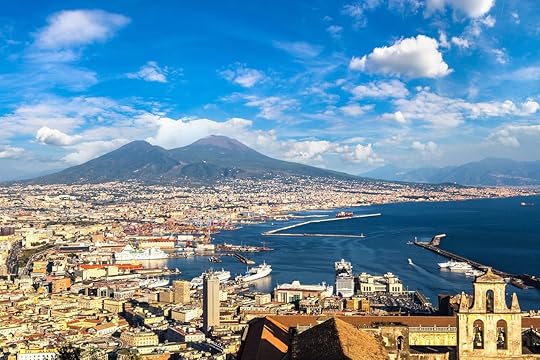
Much like the ancient ruined towns of Pompeii and Herculaneum situated in its suburbs, the city of Naples is being rediscovered. Previously dogged with a reputation for squalor, poverty, and violence, the largest city in southern Italy was regarded as somewhere that visitors scuttled through on their way to neighbouring locations such as Capri and the Amalfi Coast. But these days, Naples is emerging as a destination in its own right, with a thriving cultural scene, some of the best historical sites in Europe, and a firmly cemented reputation for excellent cuisine. Savvy travelers have worked out that Naples is worth a few days’ visit, with a multitude of day trips to the glorious towns and islands of the Bay of Naples easily available.
Day one
Get the lay of the land along the Via Caracciolo e Lungomare.
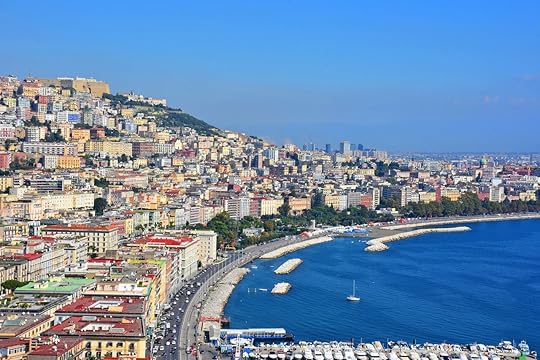
Photo: forben/Shutterstock
Naples residents love this long bayside promenade, and for good reason — this path, with a total length of nine miles, has some of the best views in the region. On one side, you have the lurking presence of Vesuvius, towering over the suburbs of Naples, and the glittering island of Capri. One the other side, you have Chiaia, one of Naples’ most vibrant neighbourhoods, with colorful houses and top-quality restaurants vying for your attention.
Quench your thirst with some local wine.
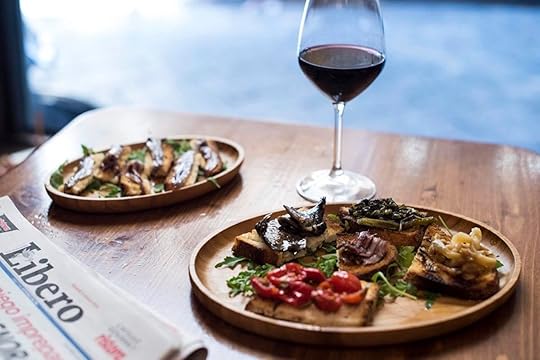
Photo: Enoteca Belledonne/Facebook
Finish off your morning with a lunchtime visit to Enoteca Belledonne, an unpretentious wine bar that’s regarded as the city’s best. Unless you’ve got a specific tipple in mind, let the staff recommend something instead — they know their stuff. Local wines are well represented, and it’s the best place in the city to sample something new. Free snacks to go along with your drinks and a relaxed atmosphere mean that you’ll be quite happy to spend a few hours here.
Check out the National Archaeological Museum.
The National Archaeological Museum in Naples houses a collection of antiquities that rivals anything in nearby Rome, especially the marble statues of the Farnese Collection — the Farnese Atlas, and the sheer size of the Farnese Bull will, leave you slack-jawed. You can also prepare yourself for a visit to Pompeii by checking out the items that were removed from the site for their own preservation. The “Secret Cabinet” is the most notorious of these, holding the finds which were considered too risqué for public view.
Try Naples’ most famous export: pizza.

Photo: L’Antica Pizzeria Da Michele/Facebook
A full day of walking and museum-going deserves a pie. L’Antica Pizzeria Da Michele might not look much from the outside — it’s tiny and decidedly no-frills — but it may well be more familiar than you think. It was featured in both the book and movie of Eat, Pray, Love, a tale that certainly gets its food recommendations right. Expect to be seated with strangers at plain tables and be given plastic cutlery and drinks in white plastic cups. You’ll also only be allowed to order either a margherita or marinara pizza (the two original varieties), but you won’t mind one bit — Da Michele only uses fresh, local ingredients, and it shows in the finished product.
Day two
Head to Pompeii.
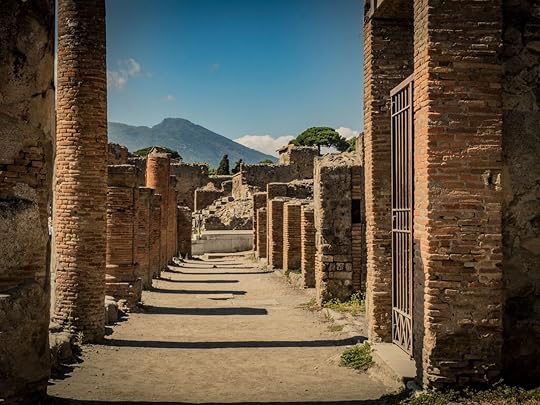
Photo: Bojan Dulabic/Shutterstock
There’s no way to visit Naples without checking out Pompeii, Italy’s most famous archaeological site. The place is huge, and you shouldn’t expect to be able to see everything in one visit, but note that you can certainly spend the whole day here.
The site’s highlights include the Villa dei Misteri with its colourful wall frescoes and the remarkably intact mosaics in the House of the Faun. The latter contains a replica of the site’s famous mosaic depiction of Alexander the Great, the original of which is preserved in the Archeological Museum in Naples.
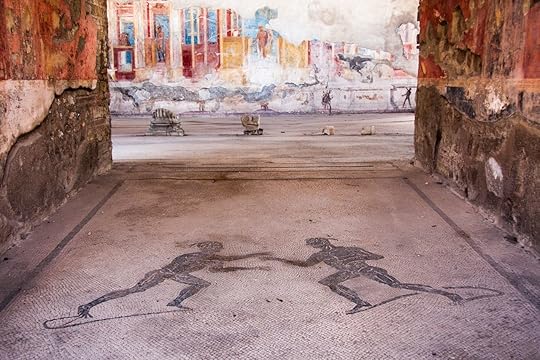
Photo: duchy/Shutterstock
The notorious brothel is also one of Pompeii’s most popular sights — expect to wait around 10 minutes to see the racy artwork decorating the walls inside. The site’s amphitheaters look like they’ve only recently been vacated, and you’ll want to spend time just taking in the atmosphere of the Forum, Pompeii’s city centre. The plaster casts of Pompeii’s victims here really draw the crowds, and you’ll find it difficult to view them without feeling for those who clearly died in terror.
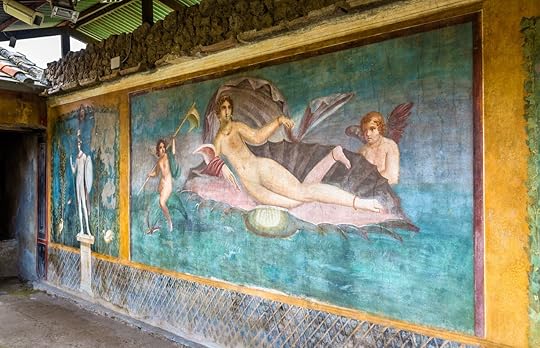
Photo: Leonid Andronov/Shutterstock
Other lesser-known must-sees are the Forum Baths and the House of Venus in the Shell, with its fresco of the goddess still remaining on the wall. Bear in mind that Pompeii was a substantial town and is sized appropriately — you’ll need to factor in a lot of walking between the highlights.
Unless you don’t mind paying the inflated prices, you’re better off not using the cramped cafeteria on site. Instead, walk along the main road into the town of Pompeii and check out Na Pasta. This little place, away from the well-worn tourist path, does excellent pasta lunches for extremely reasonable prices.
If you fancy something a little quieter but equally historic, nearby Herculaneum is smaller yet better preserved. In either case, be sure to take a hat, comfortable shoes, and plenty of water.
Indulge at Ristorante Januarius.
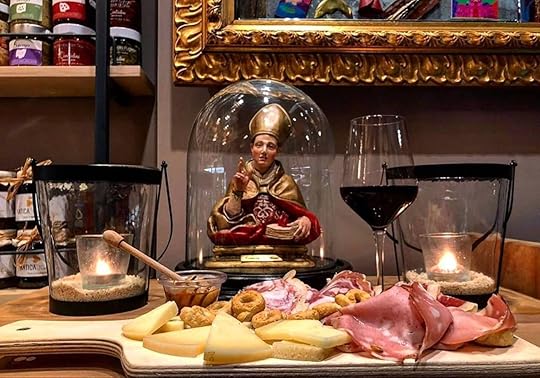
Photo: Januarius/Facebook
Januarius is located in the centre of Naples’ historic district. Named after the city’s patron saint, Januarius has a menu filled with excellent choices, including some of the very best pasta dishes in town. Try the seafood pasta for a local dish with ingredients that were probably still in the Bay of Naples that morning. Be sure to save room for dessert — the tiramisu is out of this world. There’s also a deli on site where you can purchase cheese, hams, and wines to take away.
Day three
Capri is waiting, and you should not resist.
Head down to the Molo Beverello port and buy yourself a return ticket to Capri from one of the many offices. Although this island in the Bay of Naples might be famously glamorous, it’s not all about seeing and being seen — there’s plenty of history and culture sites to visit.
Poke around Villa Jovis.
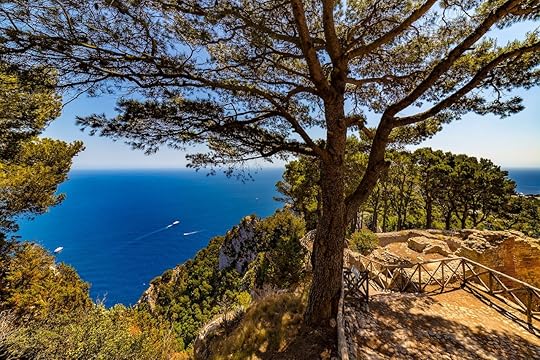
Photo: WitR/Shutterstock
One of the most interesting, and infamous, sites on Capri is Villa Jovis. It was formerly the home of the Roman Emperor Tiberius and played a large part in sealing his reputation as a cruel and ruthless tyrant. Local legend has it that the cliffs below the villa were visited by many of Tiberius’ houseguests, as those who displeased him were thrown to their deaths over a ledge.
These days, the villa is rather more peaceful. In a state of scenic ruin, they’re an easy hike to reach it and explore. For a six-euro entry fee, you can spend an hour walking amongst the remaining walls and taking in the views of the sea. Tiberius spent an extended part of his reign on Capri as he was unwilling to return to Rome — once you take in the vistas from his palace, you’ll see why.
Take a hike you won’t forget.
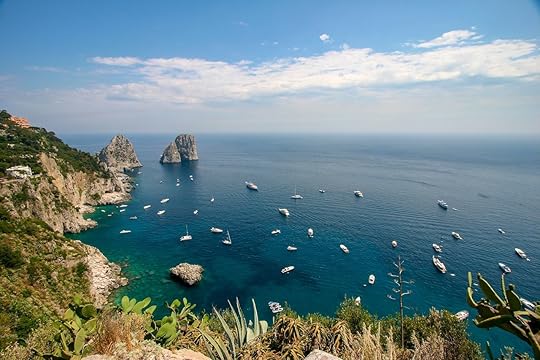
Photo: Brian Logan Photography/Shutterstock
Although many of Capri’s man-made delights command a hefty fee (not least the shops on Via Camerelle), many of its most beautiful sights are absolutely free. One of the highest-ranking among those is the hike you can take along the Pizzolungo, a beautiful trail on the southern coast of the island.
Those looking for a pleasant hike without too many vertical climbs should start near the Arco Naturale — the trail starts with a large flight of steps downwards, and you’ll definitely be glad that you won’t have to climb them up. Make your way down to the ruins at the Grotta di Matermania and take a break as you explore the temple cut into the cliff face. Once you’re on your way again, you’ll be heading down towards the sea before going through a pine forest.
After checking out some of the very exclusive villas built on the coastline, you can start heading upwards again until you reach some spectacular views of the Faraglioni — the magnificent rock formations rising out of the sea. It’s a much quieter spot for taking a photograph than popular Punta Tragara.
Cool down with a much-deserved gelato.
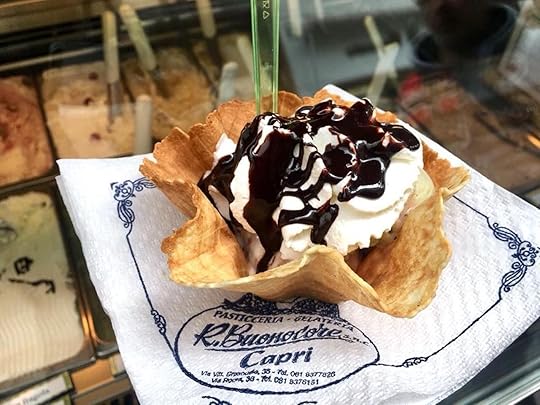
Photo: Gelateria Buonocore Capri/Facebook
You’ll need a cold treat after all that walking, and Buonocore Gelateria is the best spot. Don’t be put off by the queue, the place is worth a little wait — waffle cones are freshly made to order, the gelato is smooth and tasty (especially the crema, which is so much more flavourful than the vanilla it resembles). Another speciality is the lemon sorbet, made from locally sourced citruses, which is sweet and refreshing.
If ice-cream isn’t your thing, an array of sweet pastries are available, and each one of them is freshly made and coated with a layer of sugar. The tiny lemon cakes made from Capri lemons are a local favourite.
Sample the atmosphere at Piazza Bellini.
After you’ve taken the ferry back to the mainland, head to Piazza Bellini for a pre-dinner drink. Located just off a busy street, this is a great spot to grab some shade by day — but it really comes alive at night when the bars open, the ruins of the Greek city are illuminated, and the city’s students and bohemians come out to enjoy the evening. 1’Maggio Bar is a particularly good place to grab an Aperol Spritz and watch the world go by. Alternatively, get a table at In Tabula and sample one of its excellent seafood dishes.
Day four
Spend the morning craft shopping in Sorrento.
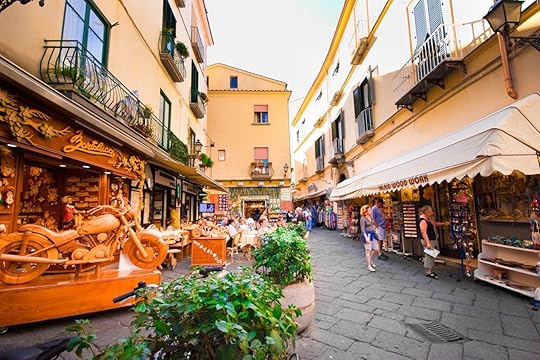
Photo: littlenySTOCK/Shutterstock
Sorrento, located on the opposite side of the bay from Naples, is a favourite with tourists, but there’s still cultural treasures among the tourist wares. Start by going along the tiny Roman lanes that sprout off the side of Piazza Tasso, and you’ll also come across some woodworking studios — there’s a particular concentration of them as you go closer to Marina Grande. As well as items such as wooden watches and fountain pens, you’ll also find craftsmen working on the famous Sorrento intarsio crafts. These are generally wooden music boxes or furniture that are decorated with intricate inlaid wood patterns and finished to a high polish. Prices vary depending on the size of the piece, but the music boxes in particular make a great souvenir or gift.
Sorrento is also known for its cameo jewellery — head along to Bimonte near the church of San Francesco, and you’ll be treated to the sight of the shop’s owner carving elaborate pendants from shells.
Have a swim in the natural pools.

Photo: Tetiana Tychynska/Shutterstock
There’s no beach in Sorrento, but there’s something even better hidden away just out of town: the Bagni della Regina Giovanna. It’ll require a short ride to get here (hop on a bus heading towards Massa Lubrense) and a walk down a path, but Sorrento’s most scenic swimming hole is easy to access. Just underneath some Roman ruins, there’s a natural pool carved out of the rock by the crashing waves.
The pool got its regal name thanks to its supposed visits by Queen Joanna of Naples, who allegedly used to bring her many lovers here for trysts. Whether that’s true or not, it’s certainly a scenic spot with a hint of the romantic.
Get your fill of seafood at Ristorante Bagni Delfino.
From one bagni to another of a completely different variety. Ristorante Bagni Delfino combines the informality of Sorrento’s dining scene with seafood that has been fished mere feet away. Try the scialatielli ai frutti di mare for something truly local; this type of pasta was invented in Amalfi and is freshly made on the premises. Add the seafood brought in the local harbor with that morning’s catch, and you’ll have a meal to remember.
Try out the Opera at the Correale Museum of Terranova.

Photo: DinoPh/Shutterstock
Sorrento hosts opera concerts at its museum, a grand former mansion, and it’s worth one evening of your time, even if you’re not into this type of music. You’ll see plenty of posters for the Three Tenors show around town, which takes place every Tuesday, Wednesday, and Saturday. On arrival at the museum, you’ll be shown into an ornate chamber for the show. The room’s size means both that acoustics are excellent and that the experience is an intimate one. Local songs are a particular favourite (get ready for “O Sole Mio”) and you can expect plenty of the standard classics.
Day five
Get an Italian art and history lesson at the Museo di Capodimonte.

Photo: Museo e Real Bosco di Capodimonte/Facebook
The Museo di Capodimonte is one of the largest museums in the country, and the building itself is both huge and staggeringly ornate. Predictably, it was formerly used as a palace and was also home to the Farnese collection. There are many fascinating pieces of art to be found here, such as the painted artworks of the Farnese collection, works by Caravaggio and Titian, and a collection of cultural items from around the world, which were collected by one of the Borgia family members.
Check out the city from below.

Photo: Napoli Sotterranea/Facebook
Exploring what lies below Naples is not only possible but also well worth your time. The entrance to the Napoli Sotterranea tour is immediately visible when you’re walking along Piazza San Gaetano — look out for the stone face above the entrance. You’ll be 40 feet beneath the surface, and a guide will take you around the remains of history — from Greek quarries and Roman cisterns to World War II shelters to flowers growing underground as part of an experiment.
The highlight is exploring the tiny passageways of the Roman cisterns. Your guide will hand you a replica Roman oil lamp, and you’ll wedge yourself into the cramped corridors that were in use so many centuries ago. Walking through seemingly endless crevices with only your lamp to guide the way is quite exciting, and you’re rewarded by seeing the underground pools that kept the Roman population watered. If that all sounds a little claustrophobic, it’s possible to skip the passageways.
Try the oldest pizza in Naples.
Antica Pizzeria Port’Alba is centrally located, has a great atmosphere, and is supposedly the oldest pizzeria in Naples. It lacks the no-frills authentic charm of Da Michele, having such frippery as tablecloths and metal cutlery, but more than makes up for it with a wide choice of pies available. There’s every imaginable topping here, and the price is right. Try the Mastunicola pizza, which is made to an original recipe dating back to 1738, for the special price of $6 — but don’t expect to taste any tomato!
End your trip on a party night.

Photo: Kestè/Facebook
Situated near the university, but frequented by people of all ages, Kesté is a bar and music club that is one of the oldest in Naples. Prices are very reasonable, and there’s always something going on — live music, including traditional local acts, comedy nights, and much more. The atmosphere truly sets this place apart: It might seem a little rough and ready from the outside, but it’s incredibly friendly once you’re inside. 

More like this: The most amazing islands in Italy you’ve never heard of
The post The perfect five-day itinerary for the Bay of Naples, Italy’s most fascinating region appeared first on Matador Network.

Quiet spots in Ho Chi Minh City
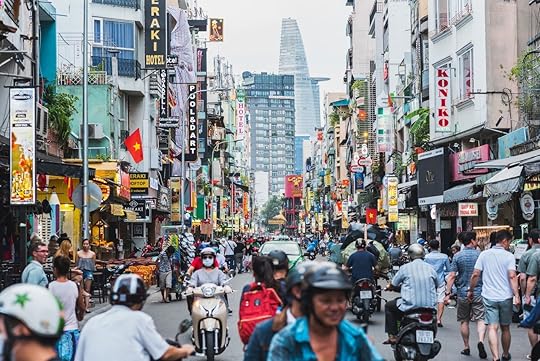
For many visitors, the incessant honking of bike, taxi, bus, and lorry horns provides the first greeting to Ho Chi Minh City beyond the arrivals hall at Tân Sơn Nhất International Airport. The sounds of the city streets provide a strident daily soundtrack in Saigon, along with karaoke being sung spectacularly off-key from a street corner somewhere, assisted by copious cans of Tiger beer and cheap speakers. South Asia has bigger cities — and ones with more impatient and hot-headed drivers — but Vietnam’s commercial capital is alive with energy and as noisy as can be. There are, though, a number of places where you’ll find serenity in the form of peace and quiet. These are the best ways to escape the noise of Ho Chi Minh City.
Nhã Nam Café, better known as “The Book Café”
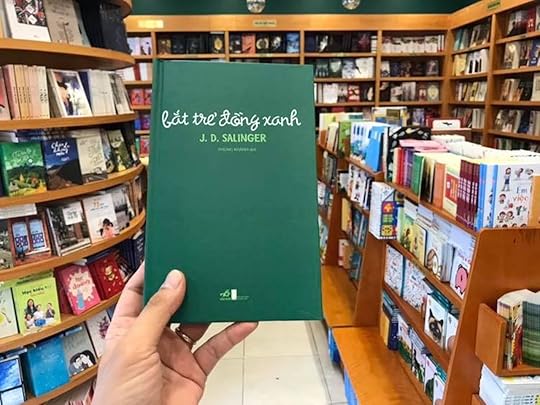
Photo: Nhã Nam/Facebook
There must be a Spotify playlist called “Saigon coffee shops” as they all seem to play the same pop tunes on repeat ad infinitum. Nhã Nam Café is special — it’s music-free and aimed at book lovers more than those after coffee and conversation. “The Hobbit” is the quietest room, where exposed brickwork, book-lined walls, and an old overgrown tree in the courtyard that wouldn’t look out of place in the aforementioned Tolkien novel combine to create a quirky, studious vibe. It’s hidden from the bustle of the street outside, creating the best place in the city to relax and put back the pages you didn’t get to on the plane.
Where: 24 Đường D5, Quận Bình Thạnh, TP
The Bitexco Financial Tower
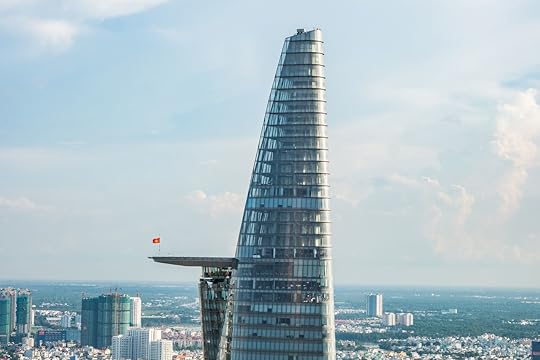
Photo: Binh Ho image/Facebook
The misnamed Landmark 81 Tower — it has 82 floors — recently usurped Bitexco Financial Tower as Ho Chi Minh’s tallest building (it’s also the tallest nationwide and the 14th highest globally). While you won’t be able to hear the engines rev and throb from that high above, the tower is very crowded with tourists, and expensive. Go to Bitexco instead. It’s $9 (a quarter of Landmark’s price) and still pretty darn tall at 856 feet high, offering a sufficiently dizzying widescreen view without the crowds.
Where: QPWC+2Q Phường 22, Bình Thạnh
Văn Thánh park

Photo: DeltaOFF/Shutterstock
Ho Chi Minh’s green spaces are dwindling as building projects arrogantly encroach, but there are still a number of parks and open spaces that offer a dose of solitude. At Văn Thánh, the toots of the motorbikes are barely audible, and if you come before 7:00 AM, you’ll catch older locals doing gentle tai chi workouts. The trick here is to come on weekdays because during weekends, the space is more crowded, and there is often electronic dance music bringing a party to the park from mid-morning until midnight. Hoàng Văn Thụ is another good place to relax on the grass and stroll the wide paths.
Where: QPW7+GR Phường 22, Bình Thạnh
The General Science Library
Even if you don’t have time to borrow, read, and return any books, the General Science Library, with a refurbished modernist design, dates back to 1868 and is even quieter than Nhã Nam Café. It’s free to visit for one day and has its own slice of history too (it was used as a prison in the 1950s). Tourists don’t come here despite it being in the heart of District 1. But you should come if Ho Chi Minh becomes too stressful. The only sounds you’ll hear are muffled whispers and the concentrated clacking of keyboards.
Where: QMGX+2G Ben Thanh, District 1
Restaurants off the main streets
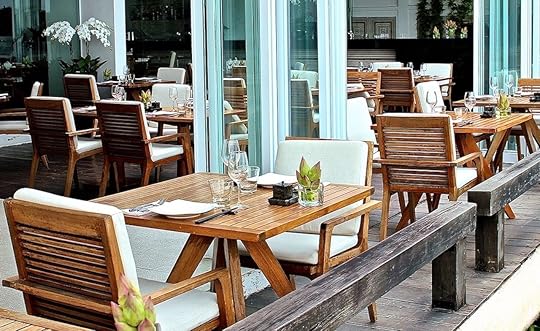
Photo: The Deck
While Bangkok gets more attention, Vietnam — and Ho Chi Minh in particular — takes its food incredibly seriously. You’ll catch whiffs of sizzling meat and simmering broth every morning when you hit the street, so do yourself a favor and oblige. You can, of course, pull up on a small plastic stool and eat on the street, but if striking up a conversation isn’t part of your plan, head for a restaurant removed from the street corners.
Reached only via a private street, the Boathouse at 40 Lily Road in District 2 has a relaxing river and an international menu of Eastern and Western dishes, and it’s one of the few places in this sprawling city where you can find a Western-style breakfast served all day. There’s also The Deck down the road, which is more romantic but twice the price. Eating in , but Chay Garden’s is a solid place to start. The restaurant’s courtyard décor — sunflower yellow walls and purple plump cushions — is a great spot to decompress over a healthy meal.
Where: Throughout the city
Ky Quang Pagoda
A Buddhist pagoda that doubles as an orphanage for abandoned children with special needs, Ky Quang II is a large, welcoming, spiritual space that exudes a bright and calm cheerfulness, assisted by several golden dragons and gargoyles. Its five levels also provide a corresponding sense of solitude. The senior monk here, Thích Thiện Chiếu, has achieved local fame and respect for his enduring love and care for the kids, and it’s incredible how peaceful the ambiance is.
Where: 79 Nguyễn Văn Lượng, Phường 17, Gò Vấp
The District
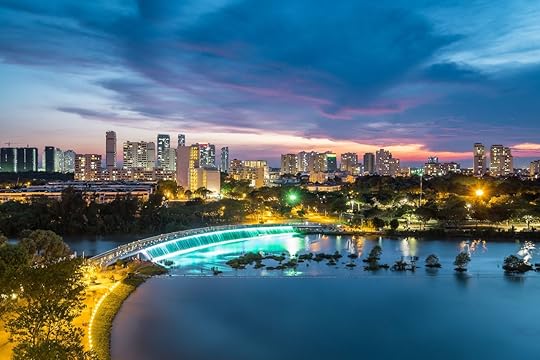
Photo: TonyNg/Shutterstock
Head to The District — District 7, or Phú Mỹ Hưng, to be precise — for a relaxing, if somewhat unusual, vibe within the heart of the city. Designed by Koreans for Koreans, this newer neighborhood is refreshingly different from downtown. Here, the traffic thins out, the roads widen, and greenery actually makes an appearance. Plus, few tourists visit, so come and watch people stroll around the manicured park behind Crescent Mall. Check out the trippy exhibits at the Artinus 3D Art Museum and the playground-meets-educational center that is Vietopia.
Before you head out, be sure to walk across the Starlight Bridge and take a photo of the waterfall. The trick here, as with the city’s parks, is to come during daylight hours as nearby bars tend to blast Korean pop music from the early evening, marring an otherwise peaceful zone.
Where: 101 Tôn Dật Tiên, Tân Phú, Quận 7
Your carefully chosen hotel
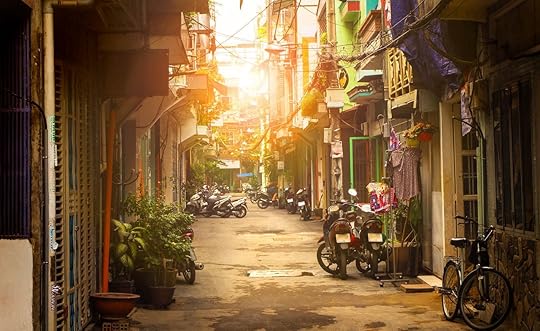
Photo: tache/Shutterstock
Ho Chi Minh never sleeps and neither will you unless you choose your accommodation carefully. Even if a high-end hotel isn’t in the budget, you should input “quiet” as a criterion when browsing hotels online. The key is to find hotels that are located in a hẻm, or alleyway, because they won’t have the motorbike noise that hotels located on main thoroughfares have to deal with. Also, stay as high up in the hotel as you can as this puts you further from the street and thus, further from the noise.
Try Fusion Suites for its alley location in District 1 (about $100 per night). To absolutely ensure you do sleep soundly, head to District 2 instead, about four miles away. Villa Song’s riverside location is tranquil but pricey, and the Thao Dien boutique hotel is cheaper and still peaceful.
The whole city during Tết

Photo: Huy Thoai/Shutterstock
For one week annually (January 24-29 in 2020), the city nearly empties as most residents head home for the Lunar New Year, known as Tết. While family-run places shut down, most tourist attractions and the restaurants that cater to them remain open, and traffic across the city noticeably decreases. So, if Ho Chi Minh appeals but you’re afraid this relentlessly impatient and noisy city will leave you feeling frazzled, come at this time. In addition to being the mellowest time of year, it’s also quite beautiful. Abundant fresh yellow and red spring flowers are everywhere — daisies, chrysanthemums, and apricot blossom — coupled with people smiling even more than they usually do make Saigon look positively radiant. 

More like this: The best way to motorcycle across Ho Chi Minh Road in Vietnam
The post Where to go to escape the noise in Ho Chi Minh City appeared first on Matador Network.

Fourth of July traditions in the US
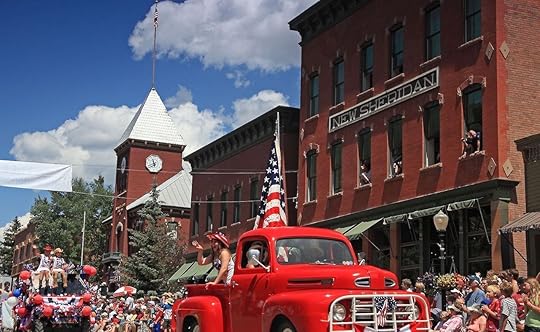
At some point in 1776, Thomas Jefferson probably turned to John Hancock and said, “You know, John, someday people will spend entire days drinking light beer, packing themselves into public parks, then trying to figure out how to use the bathroom once the fireworks start to celebrate this declaration!” This is pretty close to what happens when you attend one of the big, famous Independence Day fireworks shows in this great nation of ours.
Although seeing fireworks over the National Mall in DC or the Gateway Arch in St. Louis is great, those outings are also often a logistical nightmare. Luckily, there are other celebrations in America that are just as grand, some even bigger, and far less crowded. From an anvil launching in New York to the biggest fireworks display you’ll ever find in a city of 14,200, here are 15 fantastic Fourth of July celebrations you’ve probably never thought to attend, but should.
Key West, Florida

Photo: The Key Lime Festival
For lovers of seafood, tart desserts, and clothing-optional bars, there’s no better place to spend the Fourth of July than Key West. Here, you can kick off the day with the annual Key Lime Pie festival, downing Key lime cocktails, watching or participating in Key lime pie-eating contests, and trying frozen Key lime pie on a stick. If you’re staying on the beach at the Casa Marina hotel, there will be a big seafood grill out on 1,100 feet of beach, culminating in the big fireworks display on the water. Or, you can see it all from the clothing-optional rooftop bar on Duval Street, Garden of Eden.
Huntington Beach, California
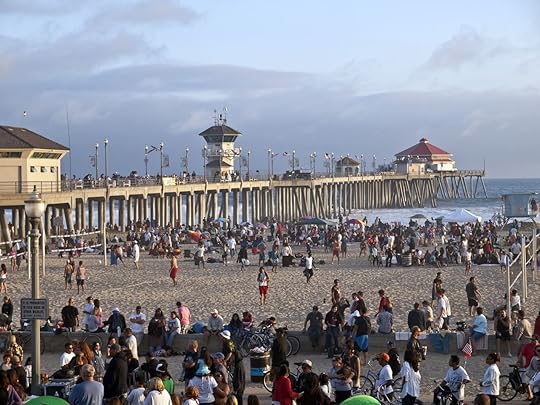
Photo: trekandshoot/Shutterstock
The largest Fourth of July parade west of the Mississippi is in Huntington Beach, the Southern California beach town best known as Surf City, USA. The festivities kick off at 7:00 AM with a 5K then continue with a 10:00 AM parade full of bands, floats, equestrian groups, and celebrity grand marshals. The beach party continues all day, ending with a 9:00 PM fireworks display and live entertainment on the HB pier.
Virginia City, Nevada
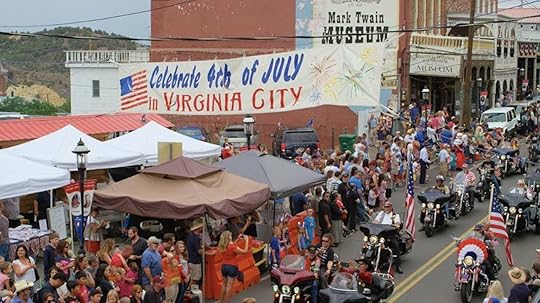
Photo: Virginia City, NV
Overhead fireworks are cool and all, but how much cooler would they be if they exploded right at eye level, with massive echoing booms and zero chance of permanent injury? That’s what you’ll get in this little old mining town southeast of Reno, where fireworks are set off in a canyon below street level, meaning that by the time they get to peak elevation they’re right smack in front of you. It’s the biggest display in northern Nevada and caps off a fun-filled day of wild-west gun shows, a parade, and historic mine and museum tours. Just consider leaving anyone averse to loud noises at home.
Put-in-Bay, Ohio

Photo: Put-in-Bay Chamber of Commerce & Visitors Bureau
If you’ve ever wondered what it would be like to combine Spring Break and the Fourth of July, get yourself to Put-in-Bay, friend. “The Key West of the North” lives up to its name on Independence Day, where this little island in Lake Erie is awash in pool parties, jam-packed bars, and half-naked people. The bars and restaurants are filled with folks from northern Ohio making the most of their short summers, and on the Fourth of July, the island that played a key role in the War of 1812 fires muskets and carronades near the landmark Commodore Perry Memorial all day long.
Jamestown-Yorktown, Virginia
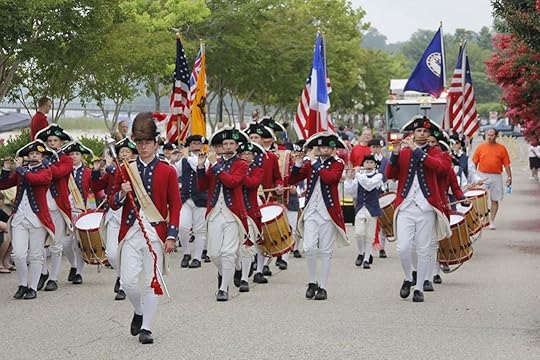
Photo: Visit Yorktown
If you’re looking for an educational Fourth of July, suit yourself, but your best bet is Yorktown’s Liberty Celebration. It’s a full day of reenactments and demonstrations that’ll excite history buffs like Black Friday excites bargain hunters, when 11:00 AM and artillery demonstration gives way to 11:30 AM fifes and drums. You can also see what training for Washington’s Continental Army was like during special training sessions, plus pose questions to soldiers in a recreated encampment, then watch live demos of military drills. It’s as close to living the revolution as you can get on the Fourth of July without somehow contracting smallpox.
The Queen Mary, Long Beach, California
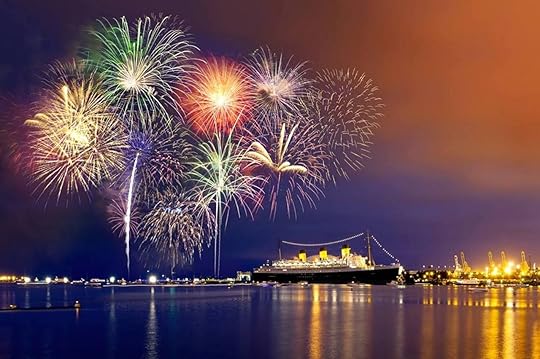
Photo: The Queen Mary
At one time this was the world’s most famous ocean liner. Now, it’s maybe the third most famous thing in Long Beach behind Sublime and Snoop Dogg, but it still throws a better Fourth of July party than either of them. On board this ocean liner docked at the port of Long Beach, you’ll find patriotic theatrical performances, games, drinks, and a private fireworks display over the Pacific Ocean. It’s not every day you get to spend the Fourth of July watching fireworks from the decks of a famous cruise ship, which is why this event typically sells out every year.
Addison, Texas

Photo: Visit Addison
Texans are a lot of things. Subtle is not one of them. That’s why one of the state’s best Fourth of July parties is simply called Kaboom Town, during which the Dallas suburb of Addison puts on a more impressive show than any other city in the Metroplex. The day features a full-on airshow with skydivers, aerobatic pilots, and military aircraft. It then transitions into a nighttime concert culminating with a 9:30 PM fireworks show, one of the biggest in Texas. This means that by regular standards, it’s probably 10 times the size of what you’re used to.
St. Augustine, Florida
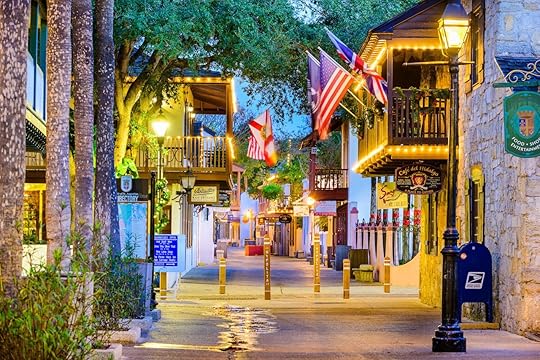
Photo: Sean Pavone/Shutterstock
You’ve probably watched enough Jeopardy! to know that St. Augustine is the oldest city in the United States. But did you also know that it’s also home to one of the largest fireworks displays on the East Coast? The 20-minute program explodes over the historic Castillo de San Marcos on Matanzas Bay, leading to an all-night party in the many haunted bars in the old city. The show is put on by the same folks who coordinate displays just down the road at Disney World and SeaWorld, and it’s set to patriotic music blared over loudspeakers along the waterfront.
Telluride, Colorado

Photo: Visit Telluride
Watching fireworks against majestic Colorado peaks is beautiful just about anywhere in the Rocky Mountain State. Of course, even reruns of Fat Albert can be beautiful in Colorado if you stop by the right store first. But in Telluride, you won’t need any herbal help to enjoy the beauty, especially when the local historic museum has free admission and root-beer floats all day long. They’ll taste extra refreshing when you catch an air show with F-16 flyovers and the biggest fireworks show in southwest Colorado, all over one of the most picturesque small-town Main Streets in America.
Niagara Falls, New York

Photo: Hethers/Shutterstock
It’s a two-for-one party at the falls this year when America’s greatest water feature celebrates Pride at the Falls. The cascading whitewater will be lit up in rainbow colors (or colours, if you’re on the Canadian side), and there’ll also be a performance from the Buffalo Philharmonic. If you’re in desperate need of fierce Independence Day competition, head to Fantasy Island for its Declaration Celebration, which will feature contests for both belly-flopping and hot-dog eating.
Charlotte, North Carolina
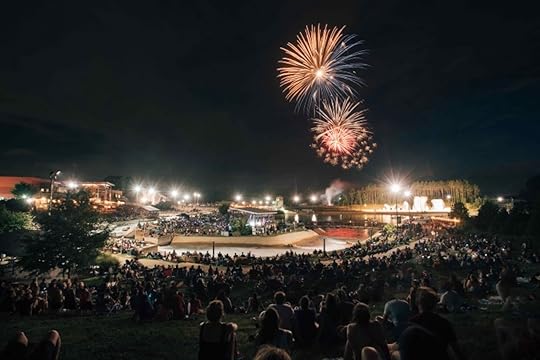
Photo: National Whitewater Center
The National Whitewater Center doesn’t inherently sound like a go-to Independence Day destination, but the world’s largest man-made whitewater river keeps the party going for two full days, starting with SUP Yoga on July 3. No, you won’t be doing yoga on whitewater but rather on the lower pond of the river, so you’re not dodging rapids while trying to hold Warrior Two. On the Fourth, you can race your friends and others in the annual Battle Royal SUP Sprint, where contestants paddle through the pond in competitive heats. The celebration also includes live music, tours of the center, whitewater rafting, and two nights of fireworks.
Chattanooga, Tennessee

Photo: Danae Abreu/Shutterstock
Though once upon a time watching explosions from the top of Lookout Mountain was a pretty terrifying prospect, on the Fourth of July it’s a fantastic vantage point to watch fireworks while reliving American history. In addition to the mountain, you can also hit the Chickamauga and Chattanooga Military Park for live artillery demonstrations. Or head down into town, where the Chattanooga Symphony and Orchestra performs a free concert on July 3, followed by a 9:45 PM fireworks celebration. For the second day of pyrotechnics, take in a Lookouts game at AT&T Park, and stay for fireworks after the game.
Seattle, Washington

Photo: bmcmillan04/Shutterstock
It shouldn’t surprise anyone that a city situated on hills between two bodies of water lends itself to spectacular Fourth of July fireworks. Any house or apartment with a good view of Lake Union is going to be a perfect place to party, but if you want to get into the heart of the action, head to Gas Works Park. Here you can watch 8,500 pounds of fireworks explode while perched on decommissioned gas pipes and machinery. The massive show is all set to the Seafair Summer Fourth score, a classical composition that’s the soundtrack to many a Seattle summer. The Fourth is also the odd time of year that’s consistently sunny in Seattle, making this an ideal weekend to visit.
Buena Park, California

Photo: Knott’s Berry Farm
Fireworks at a theme park are a good idea in theory, until you realize the rest of Southern California had the same bright idea and you spend all of the Fourth of July trapped in crowds. Not the case at Knott’s Berry Farm, which traditionally has a not-larger-than-average weekend attendance, and you can cool off in the new Calico River Rapids whitewater ride if the day gets too hot. When the sun goes down, Knott’s Summer Nights start up, with live music, s’mores, and a fireworks display capping off the night. It makes for an action-packed day without having to plan much and might be the area’s best choice for families.
Louisville, Kentucky

Photo: Louisville Waterfront Park
No city does the US flag better on the Fourth than Louisville, where no fewer than 15,000 replicas of Old Glory will line the Ohio River for the Louisville Waterfront Fourth. The annual celebration draws tens of thousands of Louisville to Harbor Lawn, where they sip bourbon in true Kentucky style while waiting for the massive Zambelli fireworks display. In the meantime, there are police, firefighters, and first responders on hand doing demos with their latest equipment. Plus a daylong live concert, this year featuring Spinsters Union of Louisville and the Zach Longoria Project. 

More like this: These are America’s top 10 spots for fireworks this 4th of July
The post The best Fourth of July celebrations you’ve probably never heard of appeared first on Matador Network.

Omani jinn, or genie, exorcisms
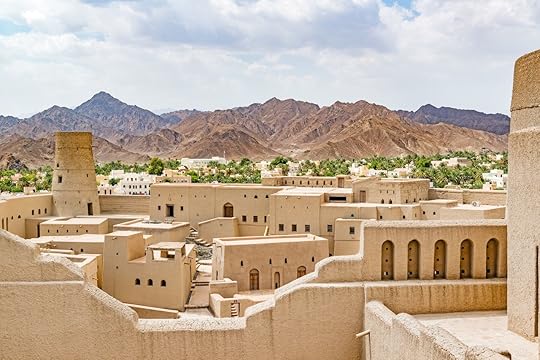
If you think sorcery is dead and gone, a trip to the Arabian Peninsula — where people are still charged with this crime punishable by prison, lashing, and sometimes death by decapitation — is very much in order. While Saudi Arabia has an anti-witchcraft unit of the religious police, the longstanding epicenter of all things that go bump in the night — including, genies, exorcisms, and voodoo — is the Sultanate of Oman.
Historically, Oman was a slave destination country. East African slaves brought their voodoo practices with them, which mixed with the pre-Islamic, polythestic belief in spirits called jinn, or genies as they are known in the West. When these beliefs collided with Islam, the legend of Bahla was born.
Bahla, Oman, is the Middle Eastern version of Salem, Massachusetts. In 2014, Bahla even made it into National Geographic’s list of the top 10 most haunted cities in the world. Living just down the road from it in Nizwa, in 2011, I penned an article for Matador Network about a famous Islamic exorcist who lived there, Moalim Salim. He claimed to have helped more than 5,000 people dispel jinn that had possessed them.
Shortly after the story was published, I received a message from a young woman who said, “I am an American — live in Boston — and have a jinn problem (and I am not crazy).”
She had done ruqya, an exorcism, already in the UAE, but the jinn possession continued, so she wanted me to fix a meeting between her and Moalim Salim as soon as possible. Despite my initial reluctance, my curiosity won out, and I agreed to make the necessary arrangements.
***
A month or so later, just on the other side of customs at the Muscat International Airport in Oman, I wait for my possessed guest with a cardboard sign displaying her name.
For her, this is a trip to find salvation. For me, an English teacher who could be deported at any time for any reason with no legal recourse, this is a huge risk. In the Gulf Cooperation Council states of Saudi Arabia, Kuwait, the UAE, Qatar, Bahrain, and Oman, people are not deported but rather imprisoned or even beheaded for dabbling in witchcraft or sorcery. A gawing pit of anxiety starts to sours my stomach.
A glimmer of recognition — she’s spotted my sign. Dark circles and bloodshot eyes tell the tale of a 12-and-a half-hour marathon flight from Boston to Muscat across eight time zones.
Amid the cacophonous flight notifications, I shake her hand and make an announcement of my own. “You don’t look like you’re possessed by a jinn,” I say, hoping to break the nervous tension as we weave our way towards the airport exit.
Arching an eyebrow, she replies, “And you, don’t look like an alcoholic.”
It’s my turn to be taken aback. I manage to smile awkwardly as we cross the line of orange and white Omani taxis outside, their drivers swarming in on us. In their national dress of dishdashas (starched white shirt-dresses) and kumas (brightly embroidered caps of Zanzibari origins), they’re eager to plunder unsuspecting tourists with exorbitant taxi fares. With a few “la, la, la shokran”, they return to the red, no-parking curb.
Interpreting the puzzled expression still lingering on my face, she explains herself, “I read your story, Notes from an ex-alcoholic skateboarder, on Matador Network.” Remembering it, I smile and nod in appreciation. I toss her luggage in the back of my blue KIA Picanto, an economy car that feels like an oven on wheels today under the Arabian sun. In the distance, an ominous dark cloud is brewing over the mountains that frame Muscat.

Photo: Philip Lange/Shutterstock
Buckling her seat belt, she asks, “Moalim Salim is going to be there, right?”
“Inshallah,” I say, switching on the AC full blast, hot air blowing in my face. “He didn’t pick up the last time I called though.” Even from a profile view in my peripheral vision, I can see her jaw tightening up.
I stiffen up as well as we cross over the six lanes of Sultan Qaboos Street, Muscat’s main thoroughfare and an incredibly dangerous road network. But with vehicular manslaughter on my mind and a sandstrom brewing in the hills, we hit the road to pick up my Omani friend Hamed — our Arabic translator — for a potentially illegal exorcism that could get us all killed.
Ascending into the foothills via the Muscat Expressway, the Indian Ocean comes into view — an infinity of blue stretching into the southern hemisphere. It stands in stark contrast to the cloud bank building over the mountains. With the eyes of the newly arrived, she takes in the scene — sepia-colored peaks, alabaster cities, a cerulean sea, and a sandstorm brewing on the northern rim.

Photo: Lukas Bischoff Photograph/Shutterstock
Rolling into Bowshar Heights, a haphazard neighborhood of manorly villas and apartment buildings on unnamed streets overlooking Muscat, I toot the horn in Hamed’s dirt driveway and give him a missed call. The wind is picking up, dust pelting the car.
He slips out the villa’s side entrance, puffing a cigarette in one hand and a tiny, plastic cup of Arabic coffee in the other. Taking one more drag before he jumps in the backseat, he flicks the smoke in the adjacent lot, slurps the rest of the coffee down, and tosses the cup to be blown away by the wind.
“That’s Hamed — always thinking of others,” I say to our guest, trying to make light of my embarrassment for his flagrant littering. Sand pummels him as he plops into the back seat. He reeks of Marlboro Lights.
I introduce the two and soon we’re winding our way up Ghala Street, the backroad through Falaj Al Sham to Highway 15. It will take us across the Hajar Mountain Range to Bahla for a close encounter with the occult and straight into the dark-brown cloud bank rolling down the mountains.
Whizzing by outside, white villas become fewer and further in between spindly clusters of ghaf trees, clinging desperately to rocky hillsides. With high speed winds now gusting unexpectedly and the light of day being blotted out by the imminent sandstorm, my crackerbox of a car is getting battered around violently. Gripping the steering wheel tightly, I switch on the lights for safety.
She turns to look at me, eyes wide with alarm, yet asks calmly, “Are we going to die?” Laughing a little too quickly, I catch Hamed’s eyes in the rearview mirror for a second and defer to him. He pulls himself up between us.
“La Qadarah Allah — God forbid, only a sandstorm,” Hamed replies automatically. The color in her cheeks has gone. “They’re dangerous but not deadly if you don’t do something stupid like drive through them,” he says looking at me. She looks away, out the dirty window. It’s getting darker. Sand blowing across the road like waves lapping at the coastline.
She turns to Hamed, “Have you talked to Moalim Salim recently? And how do you two know each other anyway?” She asks, suddenly suspicious. Turning now onto Highway 15, there’s a spattering of rain — fat drops dirtying the windshield. I flick on the wipers.
“I’ve never actually talked to the Moalim,” Hamed replies, “And this dude,” he says tapping me on the shoulder, “I met him in a 12 Step Meeting in Muscat. But I’m not an alkie like him; I’m a junkie,” he announces. Raindrops make pinging sounds on the car.
Glancing at her, I can’t resist teasing a little, “Hamed doesn’t look like a heroin addict, does he?” A sheepish, lopsided grin dimples her cheeks.
“You don’t look like an alcoholic, he doesn’t look like a heroin addict, I don’t look like I’m possessed by a jinn, and we’re all going to die together!” She blurts out, seemingly overwhelmed by the absurdity of the situation. “Tell me you don’t mind if I smoke,” she says, fumbling around in her purse for her cigarettes. She cracks her window, and the earthy aroma of rain mixes with the sour stench of her smokes. The craggy outline of the Hajar Mountains now just barely visible outside as we head deeper into the storm.

Photo: Ahmad A Atwah/Shutterstock
As the wipers on my car go back and forth furiously to mix the dust and spattered rain on my windshield into mud, I nudge our way up the Sumail Gap, the dividing line between the Eastern and Western Hajar Mountains. Visibility has dropped to just about 150 feet.
“So you have a jinn?” Hamed asks her as we summit the mountain pass. Nodding, she ashes her cigarette out the dirty window — rain splattering her black leggings. “One time in rehab there was an Omani guy there who had a jinn inside of him too,” Hamed continues. She turns to face him, inadvertently blowing smoke in our faces before trying to wave it away with her hand. “We were in group, and he just suddenly fell to the floor and started convulsing, wallah. We were shocked, but then someone thought to lay on top of him and then we all just hugged him until he stopped shaking. When khalas he stopped, this old Arabic came out of his mouth, and his voice was not his own. At that point, some of the shabab lost their shit and ran from the room. Wallahi it was heavy!”
A flow of brown water rushes through the wadi, the normally dry wash next to Highway 15, as we pass by. Local children have come to the edge of the date palm oasis in their village to watch the rising floodwaters.
“Most Muslims believe in jinn and what they’re capable of even though they are just pagan beliefs integrated into our religion,” Hamed says.
“But culturally speaking, the Arab mindset is suspiciously superstitious in that the first thought when something unfortunate occurs — someone falling ill, a reversal of fortune, or what have you — is that it is either the will of Allah or the evil eye. In either case, reciting Quranic verses are highly recommended, right, Hamed?” I ask touching the nazar, the blue-eyed talisman hanging from the rear view mirror that my Syrian wife’s grandmother gave to me against this type of sorcery.
“Iwa. It’s why we always say mashallah or tabarakallah after a compliment. It’s protection against the evil eye. It means, “God has willed this for you, blessings be upon you, and I will not envy you because of it,” Hamed explains as we arrive at Moalim Salim’s mini-castle.
The sky directly above is surprisingly clear, but a dark, inauspicious cloud clings tenaciously to the mountains surrounding us — static electricity lighting it up in flickers of blue. We’ve entered the eye of the storm.
We knock on the great wooden doors of Moalim Salim’s home and hold our breath in wait. If he’s not here, then this perilous journey will have been nothing but a fool’s errand.
A stirring of echoes, someone (or something) shuffling about inside, the lock turning, catching — the door creaking open, “Asalm alekum!” The Moalim announces, smiling broadly as if expecting us all along at this exact moment. We all breathe a collective sigh of relief that he’s actually here. Dressed in the traditional Omani garb, he cuts an imposing, if not wizardly, figure. Beckoning us into his majlis, he welcomes us with tiny cups of cardamom-flavoured Arabic coffee.
On the table in the middle of the brightly lit room are his hajahs and hars, the amulets he uses to exorcise jinns. Hamed’s eyes go wide when he sees them, flashing me a look of alarm. He’s concerned because any Islamic exorcism that uses an amulet or talisman in the ceremony to dispel a genie is strictly haram, or forbidden, because it associates partners with Allah, which, according to Shar’iah Law, is ipso facto polytheism. It’s the kind of stuff that will get your head chopped off.

Photo: Baxter Jackson
With reverence, the Moalim carefully opens this book, a thick tome made of delicate rice paper with intricate diagrams and charts scrawled in Classical Arabic. Cross referencing the alignment of the planets and stars with the time, I contacted him with her birth sign — it’s all just a matter of balancing the four elements of earth, wind, air, and fire. “When they’re out of balance on Earth,” he explains, “natural disasters occur, and as it is on Earth so it is with those Allah made of clay.” The roll of thunder in the distance is right on queue. She breathes in deeply. This is the moment she’s been waiting for.
In the bright neon lights of the room, a shadow suddenly races across the walls of the majlis — indecipherable whispers echoing in its wake. We gasp collectively and Moalim Salim declares, “Al Malak Al Aswad! The Black Prince of the Jinn!” Hamed starts chanting the Fātiḥah, the opening of the Quran, rocking back and forth. I look at her. Her eyes are wide with fright; her skin is ghostly white.
There’s no time for wuduh, the ritual cleansing of the extremities. The moalim lights up the frankincense in the mabkhara, the shiny plated incense burner. Pushing the coffee table out of the way, he instructs her to lie down in the middle of the majlis, the sitting room. The sound of thunder grows louder, nearer. As he starts chanting the Mu’wadaitain, the last two chapters of the Quran, the fluorescent tubes flicker like the lightning over the mountains. He lays his bare hand on her forehead and begins the ritual.
“I seek refuge with the Lord of the dawn, from the evil of everything that He has created, and from the evil of the darkness of night,” the fluorescent lighting pops suddenly, and the AC goes dead silent. Undeterred, the Moalim lights a candle to continue the exorcism, “and from the evil of magicians, men and women, and from the evil of the envious.” Her eyes roll back into her head, the sclera of her eyes, the windows to her soul, glowing white by the candlelight. Hamed and I look at each other nervously.
A deep sigh escapes from her lips and with it a rush of cold air like the last breath of a dying AC. Moalim Salim continues, determined to finish the sura, “I seek refuge with the Lord of mankind, the King of mankind, and the Deity of mankind, from the evil of the whisperer.” She sits up suddenly, crying out, the thunder nearly drowning out her guttural, primal scream that fills the room. He steps back, motioning for us to quickly restrain her and lay her back down as he grabs a bottle of holy water from under the amulet table.
It takes all our force to push her back down to the floor. Another shadow shoots across the wall, its whisper flickering the candle. Sprinkling her with holy water, she winces, thrashing to be set free. The Moalim is defiant in the face of Al Malak Al Aswad, the Dark Prince, as he brings the surat al falaq to its climax. “He who returns over and over again,” he cries out, “he who whispers evil into the hearts of men, whether he be from among the jinn or men — be gone!” The thunder reaches its crescendo, a powerful blast rattling the windows.
I watch her fingers, curled into claws, release their grip slowly. The electricity comes back on — the AC humming out a cool breeze while a fluorescent tube, on the blink but not dead, flickers back to life. “Subhan Allah,” Glory be to God, Hamed says in wonder as we watch her eyes roll back to the front of her sockets, her breathing returning to normal.
Moalim Salim stands up, raising the withered palms of his hands to the heavens, saying simply and humbly, “Al-hamdu lil-lah,” thanks be to Allah. Hamed and I repeat the Islamic mantra, helping her to feet; her legs are wobbly, but her eyes are clear. We pay our respects to the Moalim as he gives her final instructions to keep the jinn at bay.
She’s a little weak still so Hamed and I help her into my car. While bright eyed, she looks disoriented. With the rain having settled the dust, everything looks different — the Hajar Mountains are sharper, the sky a deeper shade of blue, the sun more radiant.
As we get into the car — Hamed in the back and me in the driver’s seat — his eyes catch mine and he mouths, “WTF?” Shrugging my shoulders and widening my eyes in my defense, I plop down next to her.
“How are you doing?” I ask her as I put the stick shift in reverse and back out of the driveway. “I feel lighter,” she says nodding her head, “like a weight has been lifted off my shoulders actually.” A smile traces the corners of her lips, “But Goddamn, I need a fucking cigarette!” Laughter fills the car as we make our way on the road back to Muscat.
“Subhan Allah,” Hamed says, Glory be to God, as he pulls himself up between the front seats, closer to us, handing her one of his Marlboro Lights. I take one too and we all light up, cracking the windows.
“So do you think you’re cured?” I ask her as we pass a family of Omanis gathered at a wadi, a normally dry wash, full of coffee-colored rainwater by the side of the road.
“Inshallah,” she says, “but I did do ruqya before in Sharjah with a sheikh there, and just when I thought it was over, the jinn came back worse than ever.” She says slipping her cigarette into an old can rattling back and forth at her feet.
During the ride, we discuss what happened — the light flickering, the whispers, the shadows, her otherworldly strength, her piercing scream. None of us can explain what we witnessed. And none of us can figure out how we made it to the Moalim’s home without being blown away in a sandstorm, killed in a car crash, washed away in a flash flood, or even arrested for sorcery. We concluded that something made sure to bring us all together that day — an addict, an alcoholic, and a possessed woman — to defeat, for now, a genie in the Sultanate of Oman.
This sense of levity and camaraderie was, unfortunately, short lived. While the jinn was exiled for a spell thanks to her visit to the Moalim, the nocturnal visits by a malevolent presence returned with a vengeful intensity that scared her enough to travel abroad again, this time further east to Indonesia for an exorcism that would involve blood and maggots. 

More like this: 9 reasons you should consider visiting Muscat, Oman, instead of Dubai
The post What it’s like to experience a genie exorcism in Oman appeared first on Matador Network.

Jim Beam barrels catch fire

No, you shouldn’t cry over spilled milk, but you should definitely cry over spilled whiskey. A Jim Beam warehouse in Kentucky’s Woodford County caught fire on Wednesday, and the contents of about 45,000 bourbon barrels has been pouring into the Kentucky River. Since one bourbon barrel holds approximately 53 gallons of bourbon, or 150-200 750ml bottles, that means around six million bottles of bourbon were lost.
Although it’s unclear exactly how the blaze started, the flames quickly spread from one warehouse to a second. Luckily, crews were able to extinguish the second warehouse’s fire before anyone was injured.
Drew Chandler, Woodford County Emergency Management director, told the Courier Journal, “I was standing 100 yards away (from the warehouse), and it’s hot. Crews can’t get close enough.” According to emergency services, there was a significant amount of runoff into the nearby river and creek.
Kentucky Energy and Environment Cabinet spokesman John Mura told the Courier Journal, “We have asked fire departments to not spray water on the fire, though they are spraying the buildings next to the warehouse. Putting water on the fire would just increase the runoff. This fire is so hot that we think the best thing to do is let it consume all of the bourbon rather than having more of it go into the stream.”
Unfortunately, officials expect a significant number of fish to die as a result of the incident, just like what happened when a bourbon warehouse collapsed in the summer of 2018. 
H/T: Courier Journal

More like this: The major differences between the world’s 10 best whiskey-making countries
The post 45,000 barrels of Jim Beam catch fire and spill into the Kentucky River appeared first on Matador Network.

Matador Network's Blog
- Matador Network's profile
- 6 followers



